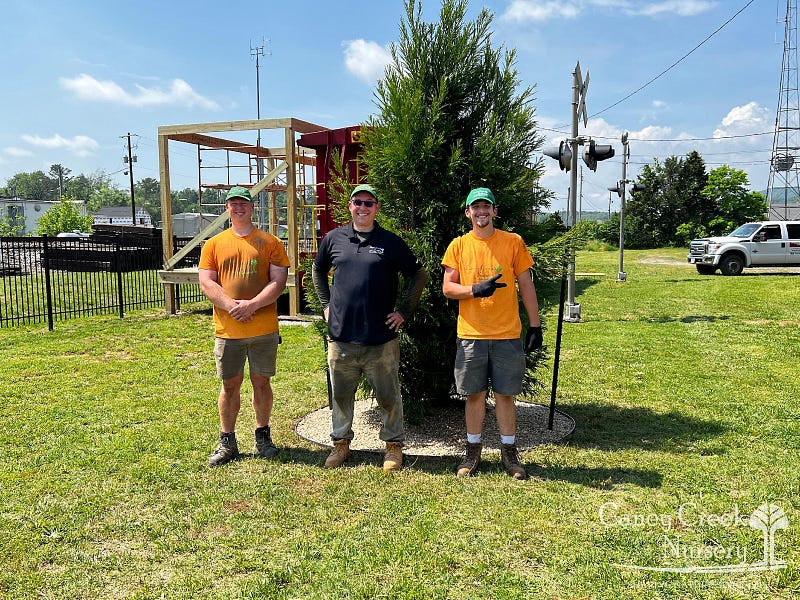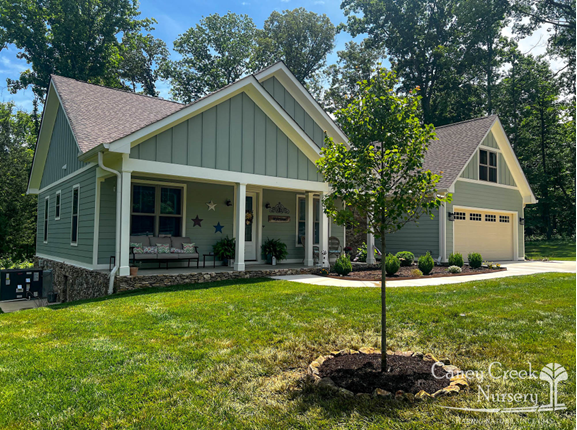Why Plant Yard Trees?
Yard trees are more than just beautiful additions to your landscape they’re long-term investments in your home’s value, the local ecosystem, and your personal comfort. Properly planted trees can offer shade, privacy, habitat for wildlife, and a sense of natural beauty that lasts for generations. But for a tree to thrive, it must be planted with intention, from the soil up. This guide walks you through the most essential elements of successful tree planting—from base design to staking techniques rooted in horticultural science.
1. Smart Design Starts at the Base
Every healthy tree begins with a well-prepared base. This includes tree rings, mulching, and edging, all of which support root health and moisture retention.
Tree Ring Size and Shape
A tree ring is a mulch-filled circle around the tree that keeps grass at bay and shields the trunk from lawn equipment. Aim for a diameter of 4-5 feet for young trees, larger for mature or transplanted trees.
Landscape fabric can suppress weeds and keep mulch in place. Use only breathable, water-permeable fabric. Avoid plastic or impermeable materials that can suffocate roots.
Edging Options
– Natural stone, brick, or pavers for rustic appeal
– Steel or aluminum for clean, modern borders
– Plastic for flexible, clean edging
Mulch: Brown, Black, or Stone?
Mulch regulates soil temperature, conserves moisture, and reduces weeds. Choose between:
– Organic mulch (hardwood, pine bark): Adds nutrients over time
– Inorganic mulch (stone such as pea gravel or river rock): Clean and durable, but can heat the soil
Avoid volcano mulching—piling mulch against the trunk causes rot and disease. Maintain a 2–3 inch depth with a clear gap around the base.
2. The Science of Tree Staking
Tree staking is one of the most misunderstood parts of planting. Many homeowners think all trees must be staked, but science tells us otherwise.
Why Avoid Staking When You Can
Trees develop strength through movement. The natural swaying in the wind stimulates thicker trunks and stronger roots—a process called thigmomorphogenesis. Unstaked trees typically anchor better and grow more naturally.
When Staking is Necessary
You may need to stake trees if:
- They’re over 12–14 feet tall
- They’re planted in high-wind areas
- The root ball is small or loose
- They’re planted on a slope
Use 2 stakes (3 for very large trees), place them outside the root ball, use flexible ties, and allow movement. Remove stakes within 6–12 months.
3. Practical Planting Tips
– Soil Prep: Loosen soil around the planting hole to help roots expand.
– Watering: Deep watering at installation and weekly for the first 4-6 weeks.
– Mulching: Reapply mulch yearly but keep the trunk clear.
– Observation: Monitor for pests, diseases, and root exposure.
4. Final Thoughts from Caney Creek
At Caney Creek Nursery, we know that a well-planted tree becomes the heart of a landscape. We’re here to help you choose the right trees and design your space with long-term success in mind.
Visit us at Caney Creek Nursery to learn more about our yard tree selections and expert landscaping advice. Let’s plant with purpose—and watch it grow.
Frequently Asked Questions (FAQ)
Q1: What if my tree leans after planting?
A: Temporary staking may help if the root ball is unstable, but the stakes should always be removed once the tree stands on its own.
Q2: Can I use colored mulch?
A: Yes, if it’s non-toxic and made from clean wood. Avoid dyed mulches made from pressure-treated lumber.
Q3: How often should I water a new tree?
A: Water deeply once when it’s installed, based on the root ball size, and then once a week for the first 4-6 weeks during the first season. Depending on rainfall or a drought scenario, you need to keep watering. Water your tree with the number of gallons of water equivalent to the root ball size.





